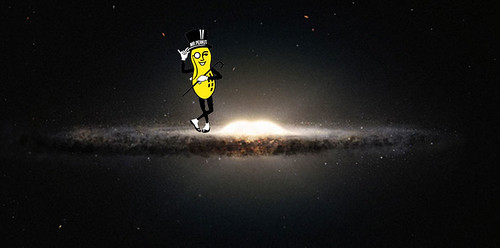Big Bang Monday: Go Nuts

Ian O’Neill’s piece on a “supermassive peanut” at the center of our galaxy caught my attention.
The central bulge of our galaxy contains around 10,000 million stars and spans thousands of light-years, but due to the obscuring dust and gas intermingled with this stellar hive, the overall shape of the bulge is poorly understood. Previous data from the Two Micron All Sky Survey (2MASS) project suggested the central galactic bulge was X-shaped — in a similar fashion to other galaxies observed in the Universe.
But using high resolution infrared data from VISTA, a better idea of the bulge’s shape has been mapped.
By focusing on 2 million red giant stars whose properties are well understood, very precise distances could be calculated. By doing this, a 3-dimensional model of the galactic bulge could be constructed.
“We find that the inner region of our Galaxy has the shape of a peanut in its shell from the side, and of a highly elongated bar from above”, said Ortwin Gerhard, co-investigator and leader of the Dynamics Group at the Max Planck Institute for Extraterrestrial Physics (MPE) in Garching, Germany. “It is the first time that we can see this clearly in our own Milky Way, and simulations in our group and by others show that this shape is characteristic of a barred galaxy that started out as a pure disc of stars.”
The second team of astronomers led by Sergio Vásquez, of the Pontificia Universidad Católica de Chile, Santiago, Chile, took a different approach to arrive at a similar conclusion. By comparing images of the central bulge 11 years apart using the MPG/ESO 2.2-metre telescope, tiny shifts due to the motions of the bulge stars across the sky were measured. This betrayed the shape of the bulge.
“The stars we have observed seem to be streaming along the arms of the X-shaped bulge as their orbits take them up and down and out of the plane of the Milky Way. It all fits very well with predictions from state-of-the-art models!” said Vásquez.
Both groups of astronomers believe that the center of the galaxy started out as a flat disk of stars, but over the aeons became buckled and warped, eventually settling into the modern day “peanut.”
Check out the ESO’s Top 100 images, some of which are available for purchase as HUGE prints here.
Tags: big bang prints, milky way, peanut galaxy, supermassive peanut